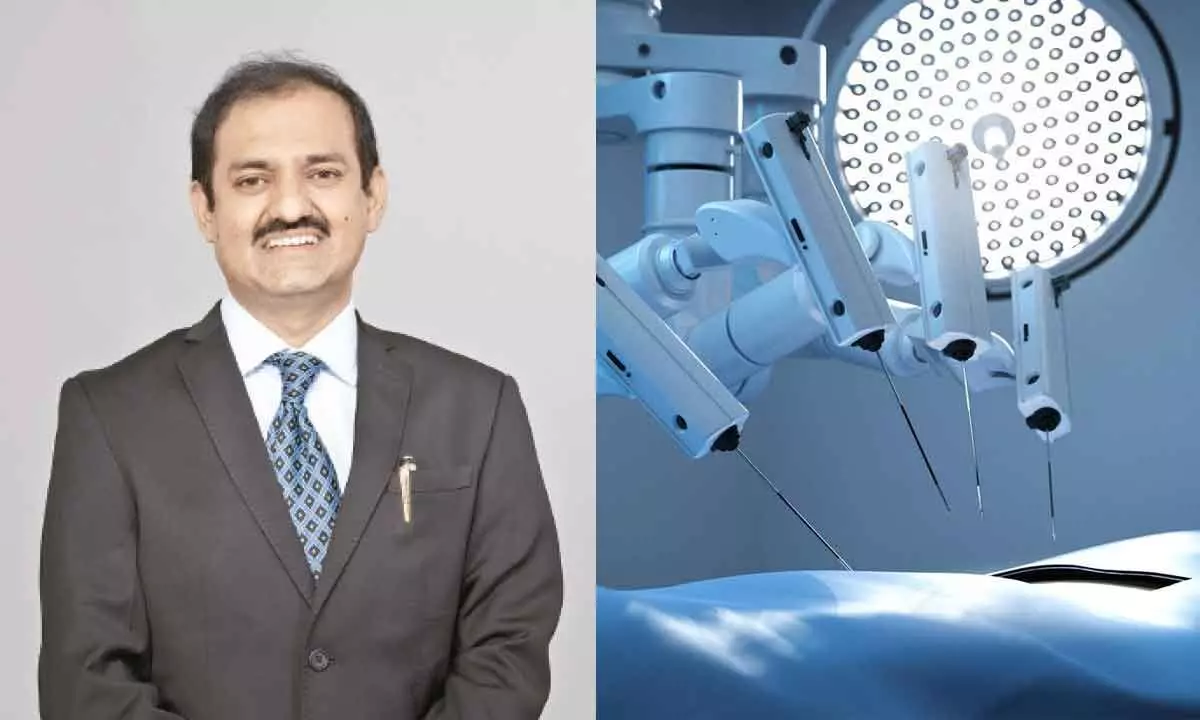Live
- They always want me to win, and now I feel lucky to have been offered a story like ‘Zebra’: Satyadev Kancharana
- ‘Democracy first, humanity first’: PM Modi in Guyana's parliament on two countries' similarities
- PKL Season 11: Telugu Titans register third straight win to top standings
- Is Pollution Contributing to Your COPD?
- NASA Unveils Underwater Robots for Exploring Jupiter's Moons
- Additional Central forces arrive in violence-hit Manipur
- AR Rahman and Saira Banu’s Divorce: Legal Insights into Common Issues in Bollywood Marriages
- 82.7 pc work completed in HPCL Rajasthan Refinery area: official
- Curfew relaxation extended in 5 Manipur districts on Friday
- Tab scam prompts Bengal govt to adopt caution over fund disbursement
Just In
Robotic Surgery - Changing the Future of Healthcare


Technology today has completely transformed the healthcare sector. Every day, several lives are improving with the advancement in surgical treatment....
Technology today has completely transformed the healthcare sector. Every day, several lives are improving with the advancement in surgical treatment. The advent of robotic-assisted surgery (RAS) has led to an exciting time as surgeons can now perform complex and new procedures with ease leading to better clinical outcomes for several lives.
With further progress in artificial intelligence (AI), machine learning and data analytics, medical devices have now enabled clinicians to personalize medicine like never before. Doctors are now able to access revelatory insights into individual patients in real-time thus making the entire healthcare ecosystem more reliable and accessible.
The success of this assistance is witnessed across varied fields such as - spine surgeries, cranial, orthopaedics, urology, general surgery, gynaecology, neurology, cardio-thoracic and gastro-enterology among many others. Leveraging technology with better utilization of human resources has also helped the hospitals in achieving operational cost effectiveness while delivering good outcomes.
Robot Assisted Surgery - The Game Changer in Healthcare Sector
Robotic surgery, also known as robot-assisted surgery, enables doctors to execute various types of surgeries and allows them to act with more precision and flexibility which may not be possible otherwise. The machine integrates advanced computer technology with the experience of the skilled surgeon and provides them with a 10x magnified, high-definition, 3D images of the body's intricate anatomy. The surgeon makes use of the controls in the console to use the special surgical instruments that are smaller, manoeuvrable and more flexible than a normal human hand. The robot then replicates the surgeon's hand movements while minimizing hand tremors and allowing the surgeon to operate with enhanced precision, dexterity, and control even during the most complex procedures.
As the technology offers a minimally invasive surgery that results in smaller scars, shorter hospital stays, faster normalcy, and fewer complications, it also enhances the experience for both surgeons and patients and is rapidly gaining momentum in the healthcare space.
Advantages of RAS
Robotic Surgery allows the localization of diseases and provides a highly refined action to address them. The technology also streamlines the preparation and the procedure allowing a greater number of patients to be treated in the same duration. Some of the benefits of RAS are increased accessibility and better decision making, Less tissue damage and faster recovery, Lesser pain due to smaller incisions and fewer chances of contracting infections, Minimal blood loss and lesser blood transfusions, Faster recovery and lesser stay at the hospital and Greater precision than the traditional methods.
During the recent covid-19 crisis, healthcare facilities not only utilised robots used not only in the operating room but were also utilized in clinical settings to help reduce exposure to pathogens and support the healthcare workers. Due to this, the sector is now witnessing increased demand for robotic surgeries as the procedure allows social distancing with lesser people around the patient and robot.
Opportunities and Way Forward
Robotics in healthcare is a welcome approach. The technological dimensions that they offer can allow us to transition from a traditional care approach to a more modern approach. With technologies evolving at break-neck speed, robots will function more autonomously and eventually perform certain tasks on their own that will allow doctors, nurses, and healthcare providers to spend more time providing direct care to the patients.
RAS can not only play a critical role in training young medical professionals to become more efficient future surgeons but will also enhance the healthcare infrastructure in Tier 2 and Tier 3 hospitals further ensuring that they are at par with the hospitals in metropolitans.
While the acceptance of robotic surgery is increasing in the country, there still lies the need for creating greater awareness about the benefits of robotic surgery. Healthcare facilities also need to understand that focus should not be laid on acquiring the asset but to develop an entire robotic program in action that involves training of the surgeons, selection of the disease profile and planning of the cost procedure based on the overall plan of cases.
As we're now gearing to take full advantage of rapidly advancing technologies, like data analytics, AI, and robotics to unlock new experiences and opportunities, for customers and patients. However, the transition from conventional surgery to robotic surgery will be complete only when accessibility and affordability are chalked out and planned accordingly.
(The writer is Global Director - AIIO - GCC & India, Lead Consultant - Surgical & Gynaecological Oncology & Robotic Surgeon, Aster CMI Hospital, Bangalore)

© 2024 Hyderabad Media House Limited/The Hans India. All rights reserved. Powered by hocalwire.com






